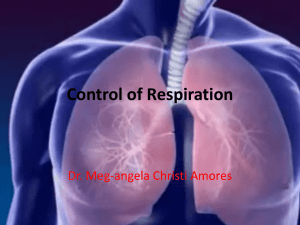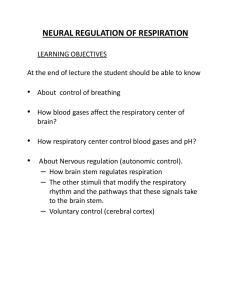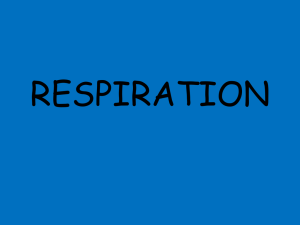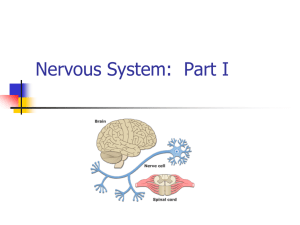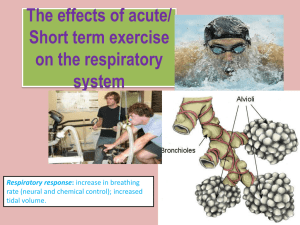Regulation of breathing
advertisement
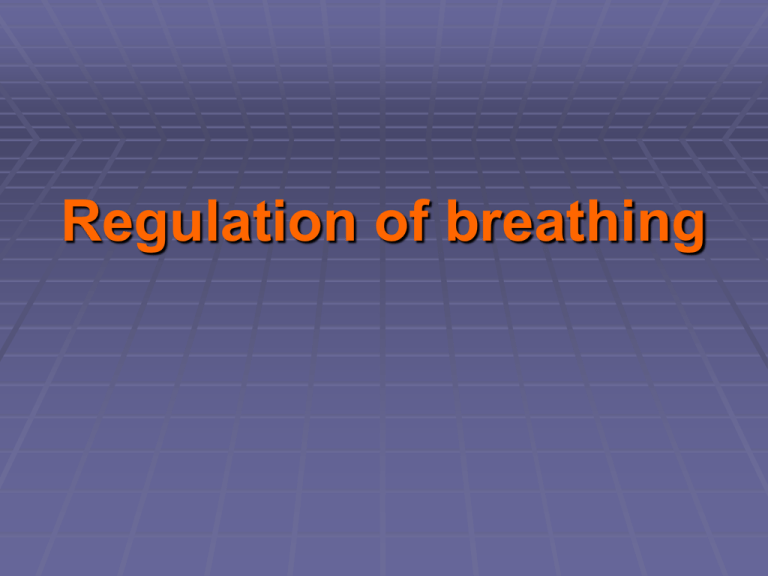
Regulation of breathing The motor neurons that stimulate the respiratory muscles are controlled by two major descending pathways: one that controls voluntary breathing and another that controls involuntary breathing. The unconscious rhythmic control of breathing is influenced by sensory feedback from receptors sensitive to the PCO , pH, and PO of arterial blood. 2 2 Inspiration and expiration are produced by the contraction and relaxation of skeletal muscles in response to activity in somatic motor neurons in the spinal cord. The activity of these motor neurons is controlled, in turn, by descending tracts from neurons in the respiratory control centers in the medulla oblongata and from neurons in the cerebral cortex. Normal respiratory movement are involuntary. They are carried out autonomically (i.e. without concious control) through the rhythmical discharge of nerve impulses from controlling centers in the medulla oblongata and pons. Respiratory neurons in the brainstem are of two types: I neurons discharge during inspiration; E neurons discharge during expiration. I neurons send out streams of impulses which travel down to the ANTERIOR HORN CELLS of the SPINAL CORD on the opposite site and are relayed from CERVICAL SEGMENTS by the PHRENIC NERVES to the DIAPHRAGM and from THORACIC SEGMENTS by the INTERCOSTAL NERVES to the INTERCOSTAL MUSCLES These nerve impulses cause the muscle of inspiration to contract In the nucleus retroambiguus (NRA) E neurons in the upper end Inhibit the I neurons during expiration PNEUMOTAXIC CENTER (PTC) (nucleus parabrachialis) Normal function unknown but may have a role in switching between inspiration and expiration MEDULLARY GROUPS The dorsal group in the nucleus of the tractus solitarius (NTS) contain I neuron. The ventral group in the nucleus NRA contain both E and I neurons. Afferent impulses in the vagus from lung stretch receptors inhibit I neuron discharge. Inspiratory neurons inhibited The muscles of inspiration relax Expiration follows passively in quiet respiration Expiratory (E) neurons are excited in force expiration Despite intensive research, the mechanism responsible for rhythmic respiratory discharge remains unsettled. The main components are in the medulla where there may be a group of pacemaker neurons situated. The regulation of ventilation by the central nervous system. Chemical regulation of respiration The activity of the respiratory centers is regulated by the O2, CO2 and H+ content of the blood. Carbon dioxide and H+ are most important. CO2 dissolves in cerebrospinal fluid (CSF) which bathes receptors sensitive to H+ on the ventral aspect of the medulla. Stimulation of these receptors is responsible for about 70% of the increase in the rate and depth of respiration in response to increased CO2. Сarotid and aortic bodies are responsible for the other 30% of the response to raised to CO2. They also increase ventilation in response to a rise in H+ or a large drop in PaO2 ( to below 60 mmHg). Increase in CO2 increases H+ concentration in CSF (CO2 + H2O in CSF H2CO3 Stimulates H+ receptors HCO3– + H+) Increases rate and depth of breathing Stimulates RESPIRATORY CENTERS Fall in blood CO2 slightly depresses shallow breathing Arterial PaO2, normally 100 mmHg, has to fall to 60 mmHg to stimulate chemoreceptors. Severe lack of O2 depresses respiratory center. CHEMO-REFLEXES: in addition to the effect of CO2 and O2 on center, rise in H+ of blood stimulates carotid and aortic bodies. Lack of O2 e.g. as at low atm. pressure (high amplitude) Stimulates CHEMORECEPTORS (‘Oxygen-lack’ receptors) in carotid body and aortic body Reflexly stimulates respiration Note: - These reflexes are usually powerful enough to override the direct depressant action of lack of O2 on respiratory centers themselves. The chemical and nervous means of regulating the activity of respiratory centers act together to adjust rate and depth of breathing to keep the PaCO2 close to 40 mmHg. This automatically sets the PaO2 to an appropriate value depending on the partial pressure of O2. For example, exercise causes increased requirement for O2 and the production of more CO2. ventilation is increased to get rid of the extra CO2 and keep the alveolar PaCO2 at 40 mmHg. More oxygen is used by the tissues. The alveolar PO2 and PCO2 both remain constant. Voluntary and reflex factor in the regulation of respiration Although fundamentally automatic and regulated by chemical factors in the blood there is a separate voluntary system for the regulation of ventilation. It originates in the cerebral cortex and sends impulses to the nerves of the respiratory muscles via the corticospinal tracts. In addition, ingoing impulses from many parts of the body modify the activity of the respiratory centers and consequently alter the outgoing impulses to the respiratory muscles to coordinate rhythm, rate or depth of breathing with other activities of the body. SENSORY STIMULI REFLEX alteration in respiratory movement Pungent odors irritating nerve ending in nasal mucosa Short inspirations, forced expirations with GLOTTIS open in sneezing. Bolus of food contacting pharynx Irritant contracting larynx, trachea Painful, hot, cold stimuli to nerve ending in skin Inhibition of respiration during swallowing. Short inspiration; series of forced expirations with GLOTTIS closed: GLOTTIS opens suddenly; blast of air carries out irritant material in coughing. Sharp inspiration after sudden pain or cold; increasing rate and depth of breathing with heat. Spasmodic Contraction of Diaphragm with GLOTTIS Closed in hiccoughing. Stretch-proprioceptors In INTERCOSTAL muscles. DIAPHRAGM ADOMINAL muscles O2 Decrease in blood pressure BARORECEPTORS In CAROTID sinus and AORTIC arch as at high altitude CHEMORECEPTORS in CAROTID BODY and AORTIC BODY Respiration stimulated. Proprioreceptors stimulated during muscle movements send impulses to respiratory center rate and depth of breathing. (NB: This occurs with active or passive movements of limbs.) In normal breathing respiratory rate and rhythm are thought to be influenced rhythmically by the Hering-Breuer reflex. Distension of alveoli at end of inspiration Stimulates stretch receptors in broncholes Stream of ingoing impulses passes along vagus nerves to inhibit inspiratory centers Withdrawal of outgoing impulses to respiratory muscles expiration


